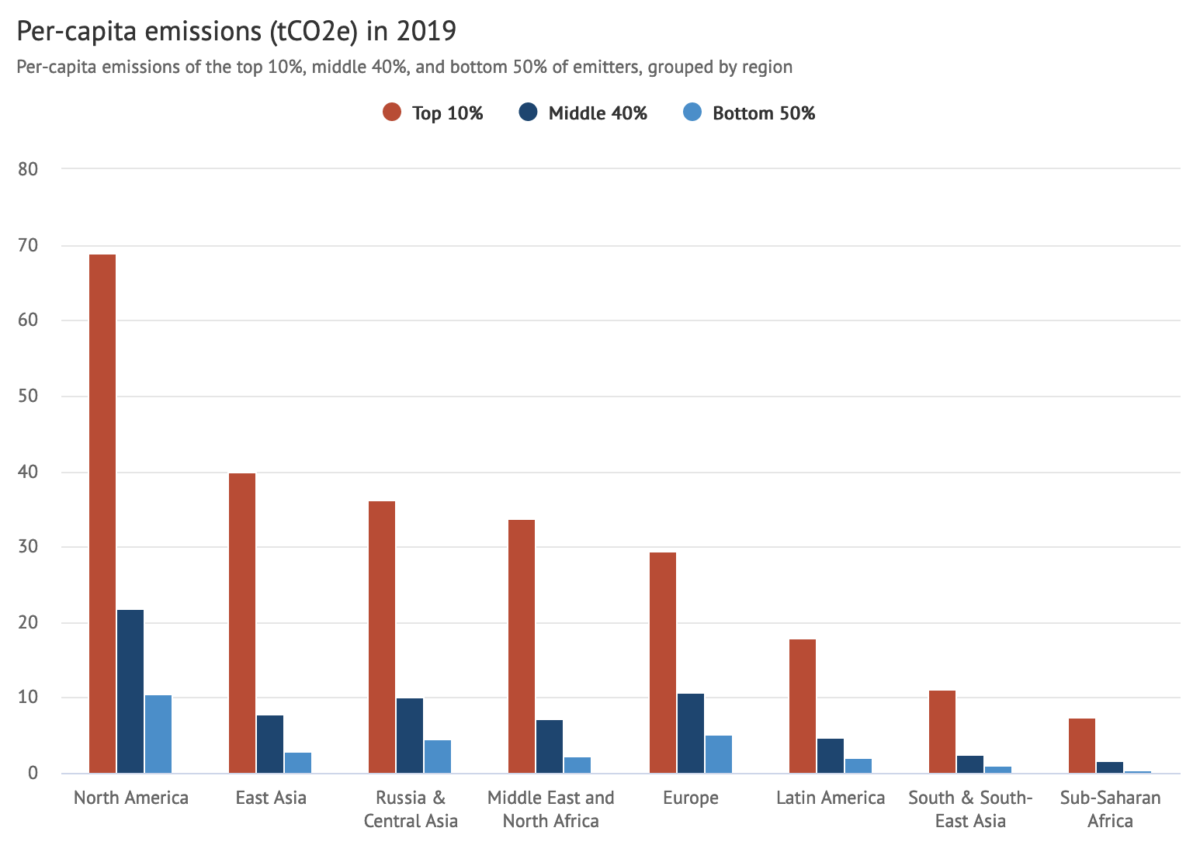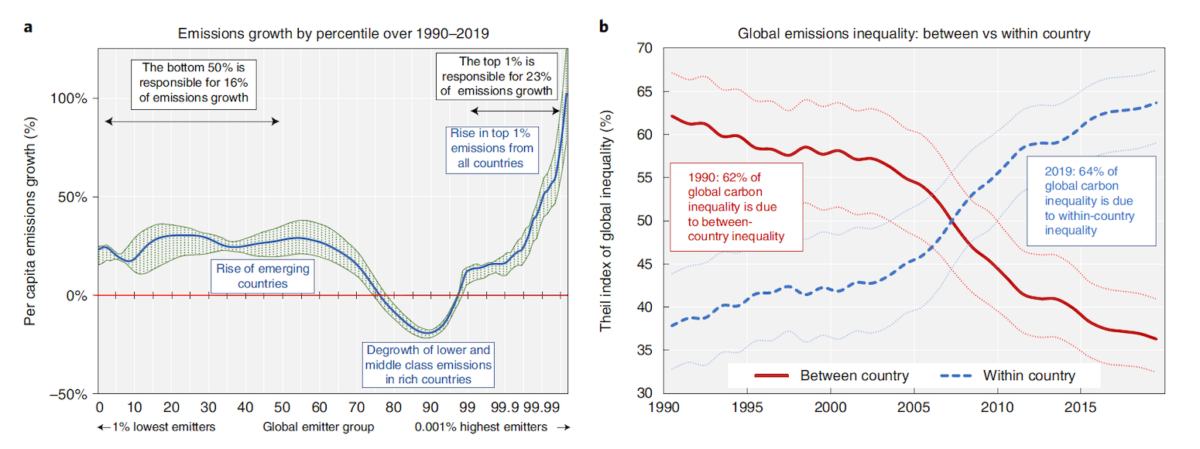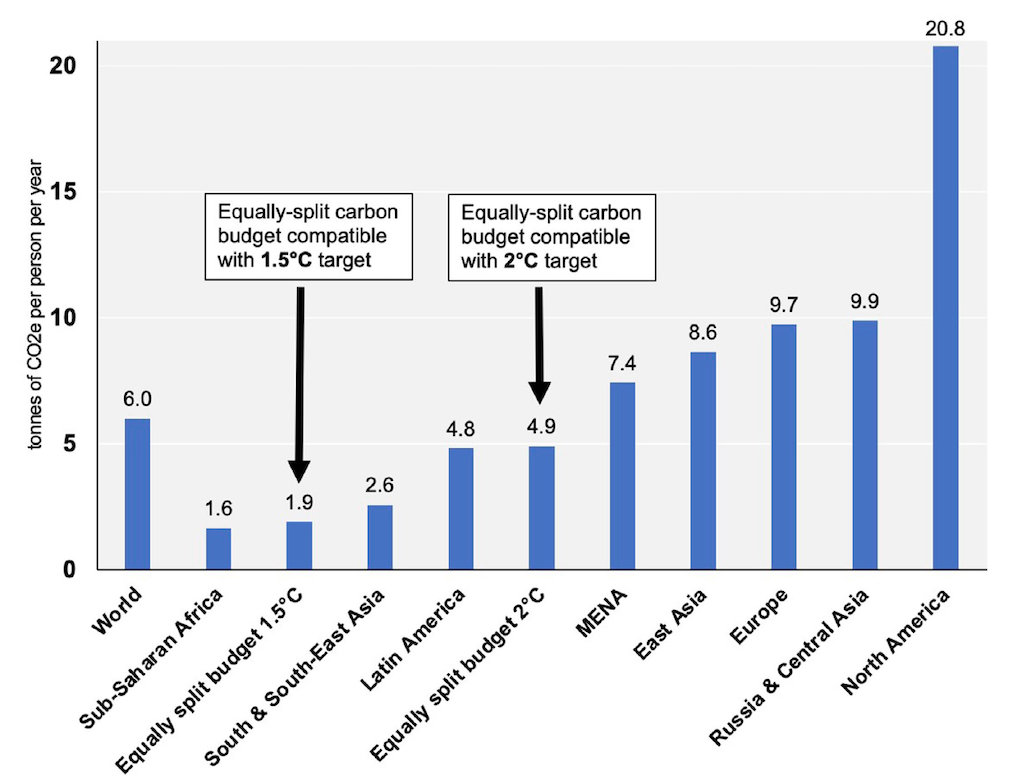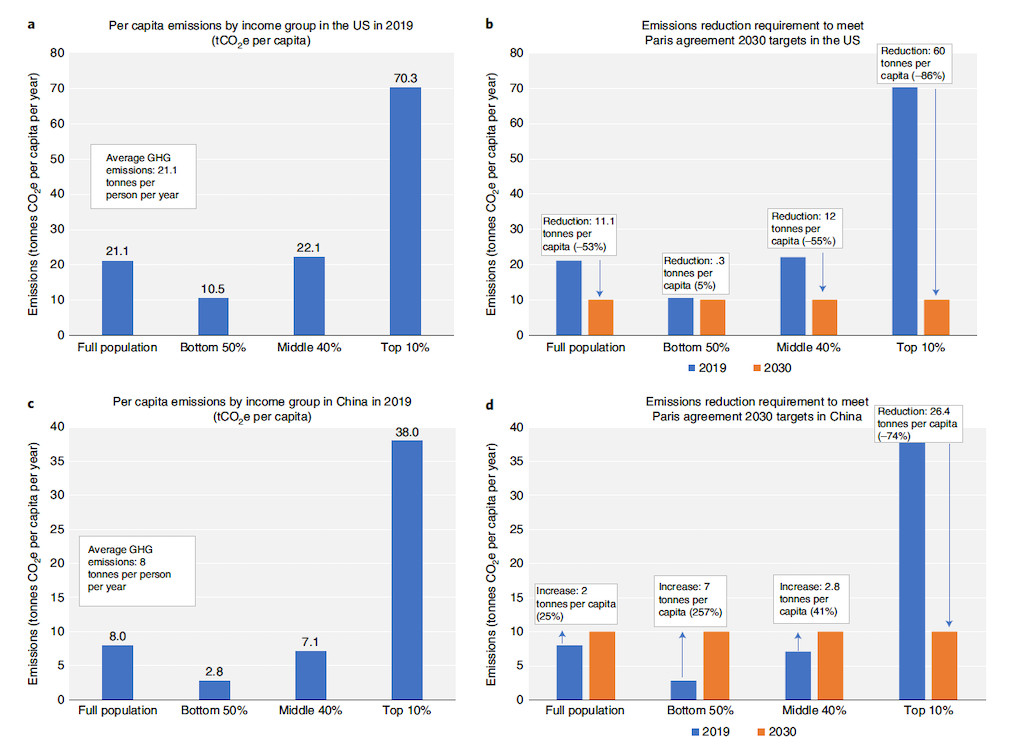Just 1% of the world’s population was responsible for almost a quarter of greenhouse gas emissions over 1990-2019, new research finds.
The study, published in Nature Sustainability, highlights the inequality in peoples’ greenhouse gas footprints — a cornerstone of the climate justice movement.
In 2019, people living in sub-Saharan Africa produced 1.6 tonnes of CO2 equivalent (tCO2e) each on average, the study finds. In North America, average per capita was more than 10 times higher, while the top 10% of the continent’s emitters produced almost 70tCO2e.
To have a “high” chance of limiting global warming to 1.5C above pre-industrial temperatures, average global per-capita emissions need to fall to 1.9 tCO2e by 2050, the study notes.
When assessing individual contributions to global warming, researchers often focus on emissions from goods and services that people consume. This study presents an update to this method by also including the emissions from a person’s investments in their greenhouse gas footprint. This allows the study to more accurately represent the emissions of the wealthy — which largely come from investments.
“Individuals can consume carbon, but they can also own [and invest in] firms that produce carbon,” the lead author of the study tells Carbon Brief, adding that his work “is proposing a method that is going to integrate these different bits of our carbon footprints together”.
Focusing on 1990-2019, the findings show that investment was the main source of emissions for the top 1% of emitters. And the per capita emissions of the top 1% grew by 26%, while the top 0.01% saw growth of 80%.
Wealth and Emissions
Humans release billions of tonnes of CO2 into the atmosphere every year. However, these emissions are disproportionately produced by wealthier people, who typically live more carbon-intensive lifestyles.
Recent research suggests the average person living in sub-Saharan Africa produces 0.6 tonnes of carbon dioxide (tCO2) every year, while the average US citizen produces 14.5tCO2. Carbon Brief analysis has also shown that the US alone is responsible for one-fifth of all CO2 emissions since 1850.
The new paper uses an income and wealth inequality dataset from the World Inequality Database to track inequality over 1990-2019. It combines economic data with information on per-capita carbon footprints — calculated using “input-output” methodologies combined with data from the “distributional national accounts” project.
The paper assesses three components of a person’s greenhouse gas footprint. The first is private consumption — made up of emissions from the direct use of fuel and emissions embedded into goods and services. The second includes emissions from government spending in that person’s country — such as government administration, public roads or defence.
The final component of a person’s carbon footprint is investment. Dr Lucas Chancel, from the Paris School of Economics, is the sole author of the new study. He tells Carbon Brief that when someone invests in a company, they are in part responsible for the emissions produced by the day-to-day activities of that firm.
Chancel highlights the global inequality between high and low emitters:
“I find that, in 2019, the bottom 50% of the world population emitted 12% of global emissions, whereas the top 10% emitted 48% of the total.”
Looking in more detail the 174 countries included in this study, he shows the inequality between high and low emitters in different regions. The plot below shows tonnes of CO2 equivalent emitted per person per year for the top 10% (red), middle 40% (dark blue) and bottom 50% (light blue) of emitters in different regions of the world.

Sub-Saharan Africa has particularly low per-capita emissions. The bottom half of emitters are responsible for just 0.5tCO2e each year, while the top 10% emit around 7.5tCO2e.
In contrast, even the bottom 50% of emitters in North America have annual emissions above 10tCO2e. Meanwhile, the top 10% of the continent’s emitters are responsible for almost 70tCO2e every year.
Dr Anne Owen — a senior research fellow at the University of Leeds, who was not involved in the study — tells Carbon Brief that this is “an ambitious and impressive piece of work”, adding that the “robust” data and methods “allow for a consistent comparison between countries”.
Emissions Inequality
The paper goes on to explore how per-capita emissions have changed over 1990-2019 for different emitting groups. It finds that, since 1990, average global per-capita emissions have grown by more than 2%, but that this growth was not uniform across emitting groups.
Chancel tells Carbon Brief that the broad trends in emissions inequality have not changed much over the study period, but notes that “at the very top of the distribution, you see quite a bit of action”.
He finds that per-capita emissions of the top 1% of emitters in the world grew by 26% over 1990-2019. The top 0.01% saw an even larger rise of 80%. Meanwhile, the bottom half of emitters saw a more modest 16% increase in per-capita emissions. And the “lower- and middle-income groups of the rich countries” saw a drop in per capita emissions of 5-15%.
This can be seen in the left-hand chart below, which shows the percentage change in per-capita emissions for different global emitter groups over 1990-2019 (blue line). In general, individuals in richer countries fall into the “higher emitting” groups, and are found on the right of the chart, while the lowest emitters are found on the left.

Dr Narasimha Rao – an associate professor of energy systems at the Yale School of Environment, who peer reviewed the study – tells Carbon Brief that it is “striking”, but “unsurprising” to see “the disproportionate growth in the emissions of the global elite around the world”.
Growing inequality within countries has also shaped global emissions over the past three decades, according to the paper.
It finds that, in 1990, while the average citizen of a rich country “polluted unequivocally more” than much of the rest of the world, the wealth gap between individuals within the same country was “on average lower across the globe than today”. However, “the situation has entirely reversed in 30 years”, the study says.
This is reflected in the right-hand chart above. It shows that, in 1990, the largest driver of global emission inequality was due to inequality between countries (red line). By 2019, this had shifted so that within-country emission inequality was the dominant driver (blue line).
In other words, while global emissions inequality in 1990 was primarily driven by the difference in emissions between residents of richer and poorer countries, it is now increasingly driven by the difference in emissions of people living within each country, rich or poor.
“Economic inequality within countries continues to drive a lot of the dynamics that we observe in terms of pollution,” Chancel tells Carbon Brief. He adds that understanding these inequalities is “key” to understanding “how to solve the climate crisis”.
The Top 1%
In February 2022, a group of researchers published a study on the global inequality in carbon emissions. It found that the average carbon footprint in the top 1% of emitters was more than 75-times higher than in the bottom 50%.
Dr Wiliam Lamb – a researcher at the Mercator Research Institute, who was not involved in the study – praised the paper. However, he told Carbon Brief that by focusing solely on consumption, the paper did not accurately capture the emissions of the “super-rich”, as “their earnings may be derived from investments while their expenditures can be shrouded in secrecy”.
Chancel tells Carbon Brief that “people who think about carbon footprints just from the point of view of consumption don’t have the entire picture”. By using a “systematic combination of tax data, household surveys and input-output tables” the new study is able to more fully represent the emissions of the very wealthy, it says.
Chancel adds:
“Individuals can consume carbon, but they can also own [and invest in] firms that produce carbon. So here the exercise is proposing a method that is going to integrate these different bits of our carbon footprints together in a consistent framework where I’m not counting the same tonne of carbon twice.”
The plot below shows the percentage of emissions from different emitter groups that come from investments — rather than consumption of goods and services or government spending.

For the top 1% of emitters, the majority of emissions can be traced back to investments, the study finds. It adds that while the share of emissions linked to investment has risen for the top 10% of emitters over the past decade, it has dropped for the bottom 50%.
Chancel explains that this change in investing patterns is driven by the rising wealth gaps within countries.
Dr Klaus Hubacek — a professor of science, technology and society at the University of Groningen, and author of the study published earlier this year — tells Carbon Brief that he is “excited” about the inclusion of investments in this study and that “more effort needs to go into that direction”.
Warming Targets
To put these results into context, Chancel compares present-day emissions to those needed to limit warming to 1.5C or 2C above pre-industrial levels.
The plot below shows average carbon footprints in different regions of the world in 2019 and the average global emissions needed to limit warming to 1.5C or 2C – assuming that emissions are split evenly across the global population.

The plot shows that to limit warming to 1.5C, average per-capita emissions need to drop by more than two-thirds from their 2019 value of 6tCO2e. This would require all regions except sub-Saharan Africa to reduce emissions, the paper says, and citizens of North America would need to slash its emissions more than 10-fold to meet the target.
In addition, a “large part of the population in rich countries already appears to be near 2030 national climate targets when these are expressed in per-capita terms”, the paper notes.
For example, it says, “nationally determined contributions (NDCs) established under the rubric of the Paris Agreement imply a per-capita target of around 10t of CO2e in the US”. The chart below shows 2019 per-capita emissions by income group (left) and how much these would need to change to meet the 10tCO2e target (right) for the US (top) and China (bottom) for 2030.

In the US, the richest 10% of the population would have to reduce its emissions by nearly 90% to reach the 2030 target. However, the bottom 50% of emitters would need to make little change.
In China, the difference between emitter groups is even more noticeable. All but the top 10% of the population could stay below their personal greenhouse gas allowances, even if their emissions rise considerably between today and 2030, the study finds. However, the top 10% of the country’s emitters would need to slash emissions by around three-quarters.
“Much is written about the emissions-intensive growth of people buying new appliances and cars as they rise out of poverty”, Rao tells Carbon Brief. However, he says this study “starkly reveals the need to focus on luxury emissions”.
Chancel tells Carbon Brief that he would like to see governments keeping track of how emissions are distributed across their countries, as they do with wealth and GDP data. “There is a lot of work ahead,” he says.
Truthout Is Preparing to Meet Trump’s Agenda With Resistance at Every Turn
Dear Truthout Community,
If you feel rage, despondency, confusion and deep fear today, you are not alone. We’re feeling it too. We are heartsick. Facing down Trump’s fascist agenda, we are desperately worried about the most vulnerable people among us, including our loved ones and everyone in the Truthout community, and our minds are racing a million miles a minute to try to map out all that needs to be done.
We must give ourselves space to grieve and feel our fear, feel our rage, and keep in the forefront of our mind the stark truth that millions of real human lives are on the line. And simultaneously, we’ve got to get to work, take stock of our resources, and prepare to throw ourselves full force into the movement.
Journalism is a linchpin of that movement. Even as we are reeling, we’re summoning up all the energy we can to face down what’s coming, because we know that one of the sharpest weapons against fascism is publishing the truth.
There are many terrifying planks to the Trump agenda, and we plan to devote ourselves to reporting thoroughly on each one and, crucially, covering the movements resisting them. We also recognize that Trump is a dire threat to journalism itself, and that we must take this seriously from the outset.
After the election, the four of us sat down to have some hard but necessary conversations about Truthout under a Trump presidency. How would we defend our publication from an avalanche of far right lawsuits that seek to bankrupt us? How would we keep our reporters safe if they need to cover outbreaks of political violence, or if they are targeted by authorities? How will we urgently produce the practical analysis, tools and movement coverage that you need right now — breaking through our normal routines to meet a terrifying moment in ways that best serve you?
It will be a tough, scary four years to produce social justice-driven journalism. We need to deliver news, strategy, liberatory ideas, tools and movement-sparking solutions with a force that we never have had to before. And at the same time, we desperately need to protect our ability to do so.
We know this is such a painful moment and donations may understandably be the last thing on your mind. But we must ask for your support, which is needed in a new and urgent way.
We promise we will kick into an even higher gear to give you truthful news that cuts against the disinformation and vitriol and hate and violence. We promise to publish analyses that will serve the needs of the movements we all rely on to survive the next four years, and even build for the future. We promise to be responsive, to recognize you as members of our community with a vital stake and voice in this work.
Please dig deep if you can, but a donation of any amount will be a truly meaningful and tangible action in this cataclysmic historical moment.
We’re with you. Let’s do all we can to move forward together.
With love, rage, and solidarity,
Maya, Negin, Saima, and Ziggy
